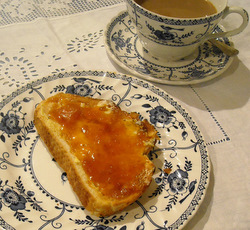Apricot and peach jam recipe
Posted by Fiona Nevile in Jam Jelly and Preserves | 16 comments
“Would you like wild plum, greengage, Victoria plum or apricot and peach?”
“Greengage I think. Well actually I’d like to try the peachy one. Can I have both?”
For years Danny and I weren’t jam sort of people. Until we started foraging, found wild cherry plums and decided to make our own. I can still remember the shock of the taste of the jam, the intense flavour with a slightly bitter sweet twist.
This year we have been making jam in earnest. It’s easy to make jam and a good jam is real comfort food of the first order. For months we’ve been eating a savoury brunch late morning. Now we’re eating earlier. Toast smothered with homemade jam is guzzled as we chat through our plans for the day.
I found some apricots and peaches knocked down in price and came up with this recipe. The peaches take a bit longer to cook than the apricots which means that the peachy chunks are suspended in the jam. The lemon juice brings out the flavours of the fruit. Stunning, packed with fruity flavour and so easy to make.
Apricot and peach jam
Yield 5 1lb jars
Ingredients:
1245g/2lb 12ozs fresh apricots
500g/1lb 2ozs of fresh ripe peaches
570ml/1 pint of water
The juice of three small lemons
1020g/2lb 4ozs of white granulates sugar
Method:
The night before you want to make the jam put the whole apricots in a heavy bottomed saucepan. Quarter the peaches and remove the stones but leave the skins on. Cover with water and bring to simmering point. When the apricots have softened turn off the heat. Cover and allow too cool.
The next day remove the peach skins (these should just rub off easily) and chop the peaches into chunks. Squeeze the apricots to remove the stones but don’t remove the apricot skins.
Add the juice of 3 small lemons (remove the pips first)
Bring the fruit, lemon juice and water to simmering point, add the sugar and stir until you are certain that the sugar has dissolved completely.
Bring to a rolling boil, stirring frequently. Testing for set after 15-20 minutes (what is testing for a set? See tricks and tips below). If the jam hasn’t set test at 5 minute intervals, taking the pan off the heat during the process. Mine took about 25 minutes to set.
Ladle into warm sterilised jars (how do I sterilise jars? See tricks and tips below) and seal, with either waxed disks and cellophane lids or screw on lids. Label when cold and store in a dark place well away from damp.
Tips and tricks:
Jam “set” or “setting point”:
Getting the right set can be tricky. I have tried using a jam thermometer but find it easier to use the following method. Before you start to make the jam, put a couple of plates in the fridge so that the warm jam can be drizzled onto a cold plate (when we make jam we often forget to return the plate to the fridge between tests, using two plates means that you have a spare cold plate). Return the plate to the fridge to cool for approx two minutes. It has set when you run your finger through it and leave a crinkly track mark. If after two minutes the cooled jam is too liquid, continue to boil the jam, testing it every few minutes until you have the right set. The jam is far more delicious if it is slightly runny.
Sterilising the jars:
We collect jars all year round for our jelly, chutney and jam making sessions. I try to soak off labels and store the clean jars and metal plastic coated screw-top lids in an accessible place. The sterilising method that we used is simple. Just before making the jam, I quickly wash and rinse the jars and place them upside down in a cold oven. Set the temperature to 160c/140c for fan assisted. When the oven has reached the right temperature I turn off the heat. The jars will stay warm for quite a while. I only use plastic lined lids for preserves as the all-metal lids can go rusty. I boil these for five minutes in water to sterilise them. If I use Le Parfait jars, I do the same with the rubber rings.
Leave a reply






What is a punnet???
Hi Marian – a small basket – I am not sure if there is a standard size. Wikipedia says “A punnet is a small box for the gathering and sale of fruit and vegetables, typically small berries. The word is largely confined to Commonwealth countries “